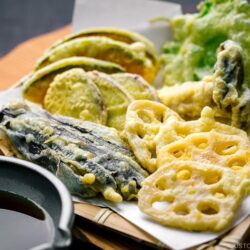
Vegetable Tempura
Who can resist delicious and crispy homemade vegetable tempura? When making tempura at home, the goal is a crispy yet airy coating that doesn‘t absorb oil when deep-fried. I’ll teach you how to achieve excellent results in this recipe.
Ingredients
- 1 Japanese sweet potato (Satsumaimo) (unpeeled)
- ⅛ kabocha squash (unpeeled and seeded)
- 2 inches lotus root (renkon) (peeled and precooked; I used boiled lotus root (renkon no mizuni) from a Japanese grocery store)
- 2 king oyster mushrooms (eringi)
- 1 Japanese or Chinese eggplant
- 4 shiso leaves (perilla/ooba)
For the Batter
- 1 cup all-purpose flour (plain flour) (chilled; please weigh your flour; click the Metric button for weights; or learn how to measure flour with a measuring cup)
- 200 ml iced water (¾ cup + 4 tsp)
- 1 large egg (50 g each w/o shell) (chilled)
For the Dipping Sauce (Tentsuyu)
- ¾ cup dashi (Japanese soup stock) (use standard Awase Dashi, dashi packet or powder, or Vegan Dashi)
- 3 Tbsp soy sauce
- 2 Tbsp mirin
- 2 tsp sugar
For Deep-Frying
- 4 cups neutral oil (or enough for 1½ inches (3 cm) of oil in the pot; you can substitute a 10-to-1 ratio of neutral oil to sesame oil)
- all-purpose flour (plain flour) (for dusting the shiso leaves)
For Serving
- 2 inches daikon radish (grated)
Instructions
Before You Start...
- I highly encourage you to weigh your ingredients using a kitchen scale. For weights, click the Metric button above to convert the measurements to metric. If you don't have a scale, here's how to measure flour with a measuring cup: Fluff the flour with a spoon, sprinkle it into the measuring cup, and level it off. Otherwise, you may scoop more than you need.
To Make the Dipping Sauce (Tentsuyu)
- Gather the sauce ingredients.
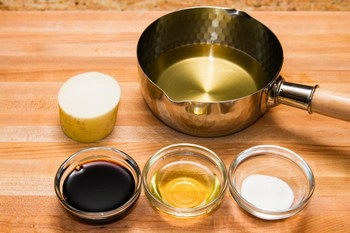
- Combine ¾ cup dashi (Japanese soup stock), 3 Tbsp soy sauce, 2 Tbsp mirin, and 2 tsp sugar in a small saucepan and bring it to a boil. Then, lower the heat and let it simmer until the sugar dissolves. Remove from the heat and set aside.
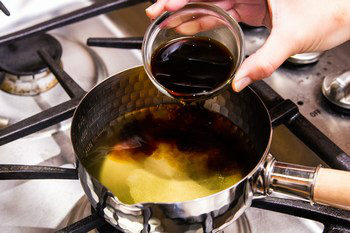
To Prepare the Vegetables
- Gather the vegetables for the tempura.
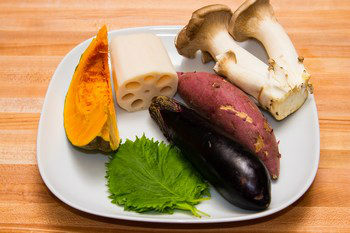
- Slice 1 Japanese sweet potato (Satsumaimo) into ¼-inch (6 mm) rounds and soak in water for 15–30 minutes to remove the excess starch. Then, pat dry with paper towels. Tip: For crispy tempura, make sure the vegetables are completely dry. Excess moisture will make the tempura soggy.
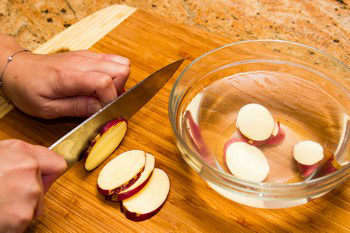
- Cut ⅛ kabocha squash and 2 inches lotus root (renkon) into slices ¼ inch (6 mm) thick. Soak the lotus root in vinegared water (2 cups water + 1 tsp vinegar) for 5 minutes. Pat them dry with paper towels.

- Cut 2 king oyster mushrooms (eringi) lengthwise into thin slices.
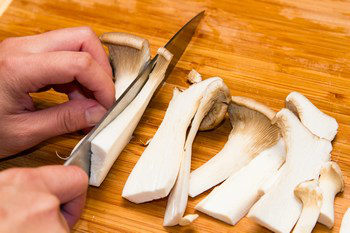
- Set aside 1 Japanese or Chinese eggplant for now; prepare it immediately before you deep-fry it. When ready, cut off the stem and calyx, then cut in half lengthwise. Place them cut side down on the cutting board. Leave the top 1 inch (2.5 cm) of the stem end intact so the eggplant stays attached, and cut the rest of it lengthwise into thin slices about ⅛ inch (3 mm) thick. Then, gently press down on the slices to fan them out. Keep the 4 shiso leaves (perilla/ooba) whole.

To Heat the Oil
- Once you've prepared the ingredients, add about 4 cups neutral oil to a depth of 1½ inches (3 cm) to a deep fryer or pot and preheat it to 320°F (160°C). Use an instant-read thermometer for precise temperature control. To check with wooden chopsticks, dip them in the oil; when small bubbles form around the tips, the oil is ready. Tip: For enhanced aroma and taste, I like to add 1 part sesame oil for every 10 parts neutral oil.
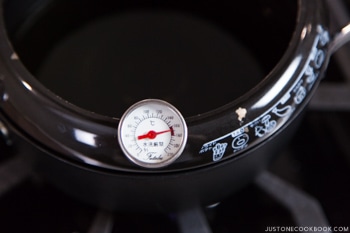
To Make the Batter
- While the oil is heating up, prepare the tempura batter. We‘ll use a 1-to-1 ratio (by volume) of flour to egg + water. Gather all the ingredients.
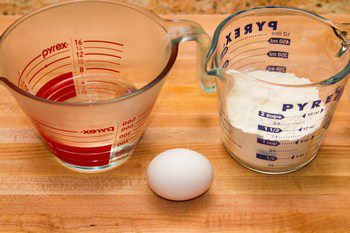
- Sift 1 cup all-purpose flour (plain flour) into a large bowl.
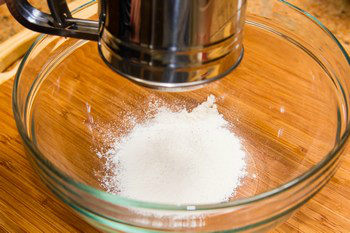
- Add 200 ml iced water to a measuring cup or bowl. Then, add 1 large egg (50 g each w/o shell).
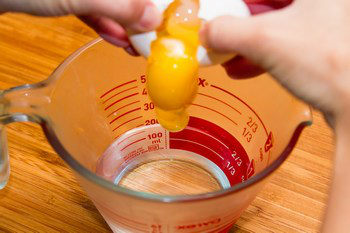
- Whisk the egg and water mixture vigorously and discard the foam on the surface.

- Slowly pour the egg mixture into the flour while mixing with chopsticks in a figure 8 pattern for about 15–20 seconds. Do not overmix to avoid activating the wheat gluten; it‘s fine to leave some lumps in the batter. Keep the batter cold at all times by adding 1–2 ice cubes to the batter or by setting the batter bowl in a larger bowl of iced water.
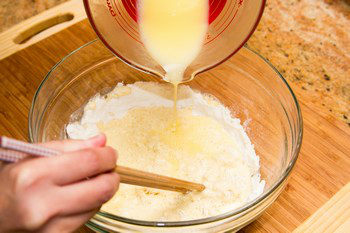
To Deep-Fry
- When the oil is heated, deep-fry the sweet potato and lotus root (the root vegetables) at 320°F (160°C) for 3–4 minutes until lightly golden. Dip one piece in the batter, let the excess drip off for 1–2 seconds, and gently place it into the hot oil. Fry in batches and do not crowd the pot. Clean the oil of fried crumbs between batches. Maintain the right temperature at all times. Tip: Your ingredients should take up no more than half of the oil's surface area because the temperature will drop quickly if you add too much food at once. For more helpful hints, read my post on how to deep-fry food.
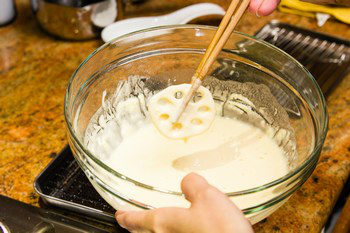
- Between batches, use a fine-mesh skimmer to remove the tempura crumbs from the oil, which will burn and turn the oil darker. Continue frying until you‘ve cooked all the ingredients.
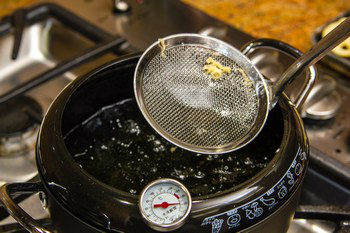
- Next, raise the oil temperature to 338–356°F (170–180°C) and deep-fry the kabocha, eggplant, and mushrooms for 1–2 minutes. Dip and add one piece at a time. Fry in batches and maintain the target oil temperature.Finally, deep-fry the shiso leaves for 15–20 seconds. To batter them, sprinkle a bit of sifted all-purpose flour (plain flour) on the back of the leaves and dip only the back of the leaf into the batter. Tip: The extra flour acts as a glue that helps the batter adhere to the shiso leaf.
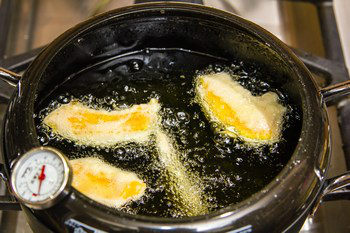
- Deep-fry until lightly golden. Transfer to a wire rack or paper towel to remove the excess oil.
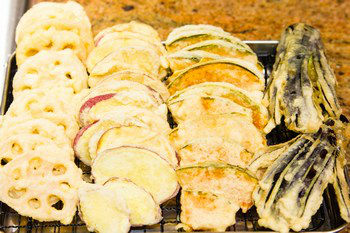
To Serve
- Peel and grate 2 inches daikon radish and gently squeeze out some of the liquid.
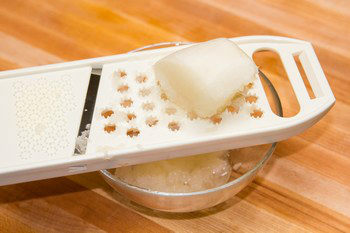
- Prepare 3–4 Tbsp of warm tentsuyu in each individual dipping bowl with 1 Tbsp grated daikon per serving on the side. Serve immediately. Mix some grated daikon into the dipping sauce for a refreshing taste and dip the tempura pieces to enjoy.
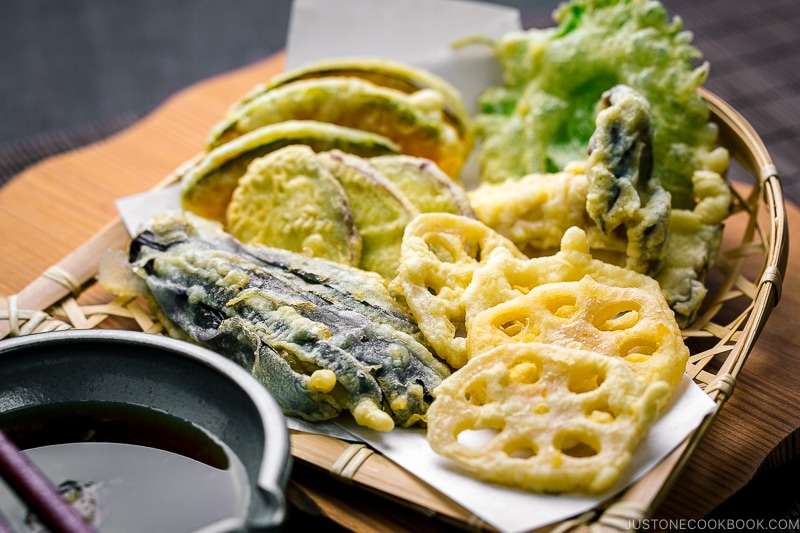
To Store
- Place the leftover tempura in a single layer between paper towels and store in an airtight container or a resealable plastic bag. Freeze up to 2 weeks. To reheat, place on a wire rack in a 400ºF (200ºC) oven or toaster oven for 5 minutes or until crisp on the outside and heated through. If you have unused dipping sauce, you can store it in the refrigerator for up to 1–2 weeks.
Nutrition
Calories: 652kcal, Carbohydrates: 82g, Protein: 16g, Fat: 30g, Saturated Fat: 23g, Polyunsaturated Fat: 1g, Monounsaturated Fat: 4g, Trans Fat: 1g, Cholesterol: 65mg, Sodium: 843mg, Potassium: 1559mg, Fiber: 12g, Sugar: 16g, Vitamin A: 16993IU, Vitamin C: 14mg, Calcium: 93mg, Iron: 6mg